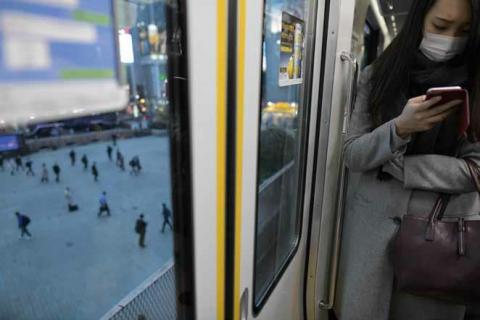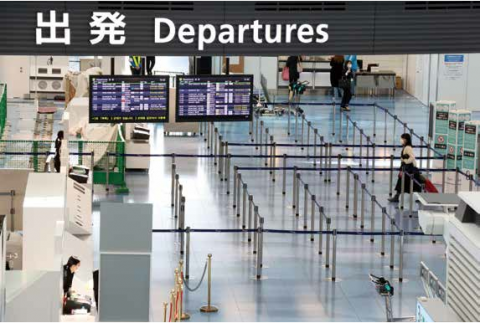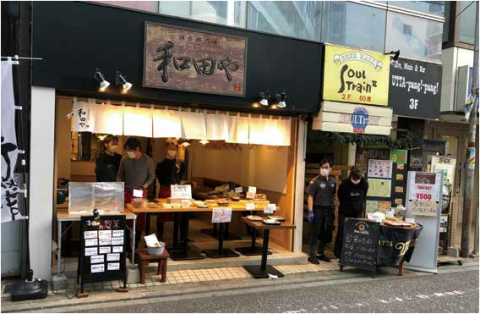Issue:
How journalists are managing the difficult task of covering Japan’s response to the epidemic

We live and work in interesting times. Obviously, for members of the media profession, to be in the thick of a story from its very early stages and then to follow the personal stories and the political maneuvering, or to chronicle the ramifications for companies and sectors through to their conclusions, is why we get into this business.
The coronavirus pandemic is different, however, because we’re not dispassionate observers and the job description means that we have to take arguably more risks than the average citizen going about their everyday life.
So just as in March 2011, when the earthquake off northeast Japan triggered a tsunami that devastated a swathe of Tohoku and set off a nuclear crisis, we are once again in the middle of the story.
In late December, the likelihood of a global pandemic that would infect close to three million people, so far, and kill more than 200,000 [both figures at press time] was unthinkable. There were sketchy reports of an outbreak in the Chinese city of Wuhan of a previously unknown strain of a virus with similarities to the flu, but conventional wisdom was that it was nothing to be overly alarmed about.
Four months later, tens of millions of people are under lockdown and more people will die, from Boston to Barcelona to Beijing, before this thing has run its course. Reporting the coronavirus crisis has been, correspondents concur, “challenging.”
“The first piece I wrote was on Jan. 29 and it was a short story about how people should protect themselves from this virus that was emerging in Wuhan,” said Justin McCurry, correspondent for The Guardian. “But it all seemed very distant at that point.”

EVEN UP UNTIL THE first cases were reported aboard the Diamond Princess cruise ship on Feb. 4, “My colleagues in London were still talking about this as if it was a north-east Asia problem as there had been only a couple of cases reported in the UK by that point, so they sent me a few masks,” McCurry said. “But then within a very short space of time it was a serious matter in Europe as well.
For McCurry and many other correspondents, the Diamond Princess became ground zero for coverage. “When it was a story about middle aged, middle class British tourists trapped on a cruise ship, then the story took off,” he said.
Social media and modern technology meant it was possible to reach passengers who were in quarantine, which was what news desks were demanding, and it was a story within an evolving narrative that made consistent and compelling copy for weeks on end.“It was something we could keep going back to and to hear how conditions on board were deteriorating, to see how people were going about sitting the thing out, to see their growing frustrations,” said McCurry, who estimates he has written nearly 90 stories or contributions to rolling news blogs on the virus for The Guardian.
Abby Leonard also contributed her first coronavirus story on Jan. 29, when Japan began evacuating its citizens from Wuhan, and is reporting for National Public Radio in the US and Time magazine. The Diamond Princess was an important part of the larger story, primarily because there were so many US nationals on board and such “drama” about getting them home, she said, but the agenda has moved on significantly.
“There’s so much news about this in the US now, it’s harder to get anyone interested in what’s happening in Japan,” she said. “At the beginning, I think coronavirus felt like an Asian story to assignment editors, so we were well positioned here in Japan. But, of course, that changed,” she said. “In recent days though, with the uptick in cases, there’s slightly more interest in whether it really takes a turn for the worse and how the Japanese government deals with that.”
EDITORS ARE NOW LOOKING for stories with parallels to what the US is likely to experience in the weeks ahead, coverage of second wave infections, economic stories and how the government is managing or mismanaging the lockdown.
“The lack of information and questionable data are big challenges, and trying to put the numbers in context for a US audience is hard when you’re not comparing apples to apples as far as testing rates and other metrics,” said Leonard, who also has an added layer of complication to her job.
“It’s been hard,” she admits. “I have a 4 year old, a 2 yearold and one on the way, so it’s nearly impossible to do anything when they’re around,” she said. “And their school has been closed since the beginning of March.
“AT THE BEGINNING, I THINK CORONAVIRUS FELT LIKE AN ASIAN STORY TO ASSIGNMENT EDITORS, SO WE WERE WELL-POSITIONED HERE IN JAPAN. BUT, OF COURSE, THAT CHANGED”
“A lot of my work is radio reporting, which I record and edit at home,” she said. “I have let my 4-year-old son listen in on some of my recording sessions because he’s really curious about what I’m doing, but it’s hard for him to stay quiet for long stretches, so that’s meant I have to do twice as many takes to get something usable. That can be frustrating probably for both of us.

Coronavirus ins and outs
Opposite: An empty departure lounge at Tokyo’s Haneda airport on March 18, after a number of flight cancellations. Above: Pubs and restaurants organize outside eating and takeaways on April 11 to stay in business during lockdown.
Drini Kakuchi writes for the UK-based University World News and has been able to concentrate on longer reads, looking at the impact of the virus on the tertiary education sector in Japan. She says the biggest hurdle has been obtaining information.
“I have built up really good relationships with health experts, and that has meant that they have always been able to find time to speak with me, even if I call at midnight, so I really appreciate that,” she said. “The problem has been company and business officials, bureaucrats, PR people who don’t want to say anything in case it appears that they’re not doing enough for their students.”
KATHRYN WORTLEY, WHO REPORTS for Singapore based TTG Asia, has had similar issues with recalcitrant spokespeople and government officials, making it difficult to get a firm grasp of the situation facing travel companies and the broader tourist sector in Japan. “I’ve definitely been given the run around when I contact organizations or companies because they’re not happy to comment on what is still an unfolding situation,” she said. “It’s often hard [in normal times] to get officials, even PR people, to give you an answer to something that’s fairly easy, so it’s a hundred times worse now.”
The best way of overcoming that hurdle, she has learned, is to cultivate as many new contacts as possible, get existing contacts to put in a good word with someone else in the industry who might otherwise be leery about speaking to an unknown foreign reporter and “just keep on my toes.”
Abby Leonard says that in the same way that March 2011 taught us lessons we never knew we needed previously, the early months of 2020 are demonstrating a whole new set of needs both in terms of journalists trying to do their jobs and society’s need for the media to fulfill its duty.
“There is a need to question authority and push for more government transparency; [to accept] that explanatory journalism is hard and ecessary that it’s important to have experienced foreign journalists in Japan to help explain what is really going on, on the ground,” she said. “Also, that quality, available childcare is essential, and we need to find innovative ways to support working parents in times of crisis.”
I, PERSONALLY, WOULD ECHO all these comments but I’m still finding it difficult to get my head around how unangry the Japanese public and media are at the situation the nation finds itself in. The Telegraph is a solidly conservative newspaper that was firmly in Boris Johnson’s corner in last year’s election, but it has still been sharply critical of mistakes and mismanagement in his administration’s response to the coronavirus crisis in the UK. And rightly so.
But here, the front pages of the papers and the television coverage merely seem to parrot the government line. Where are the angry opeds asking why just 11 percent of deaths merit autopsies and why, therefore, it appears that people who may have died of coronavirus are being listed as having succumbed to pneumonia? Why no outrage over the shortage of protective kits for emergency staff, hospitals turning away people who are clearly ill and, most obvious of all, the failure to test more than a fraction of the people?
After March 2011 and the failures that disaster laid bare in the way that the government talked down to the public and the media reinforced rather than rebutted that message, I had hopes that things might change in Japan. By the time the statistics on pneumonia deaths in the early months of 2020 are released five months later, we are being told any anger that might have resulted from inexplicably sharp spikes in the fatalities will have already dissipated.
So Japan moves on to the next crisis no better prepared and its politicians held no more accountable for their action or inaction than before. And we’re left to live in hope.
Julian Ryall is Japan correspondent for The Daily Telegraph.

